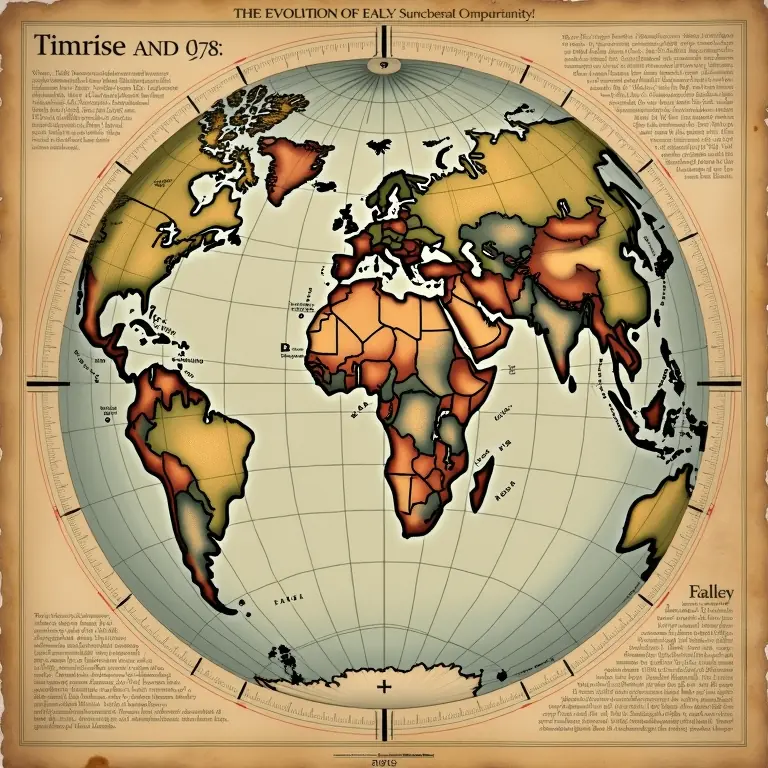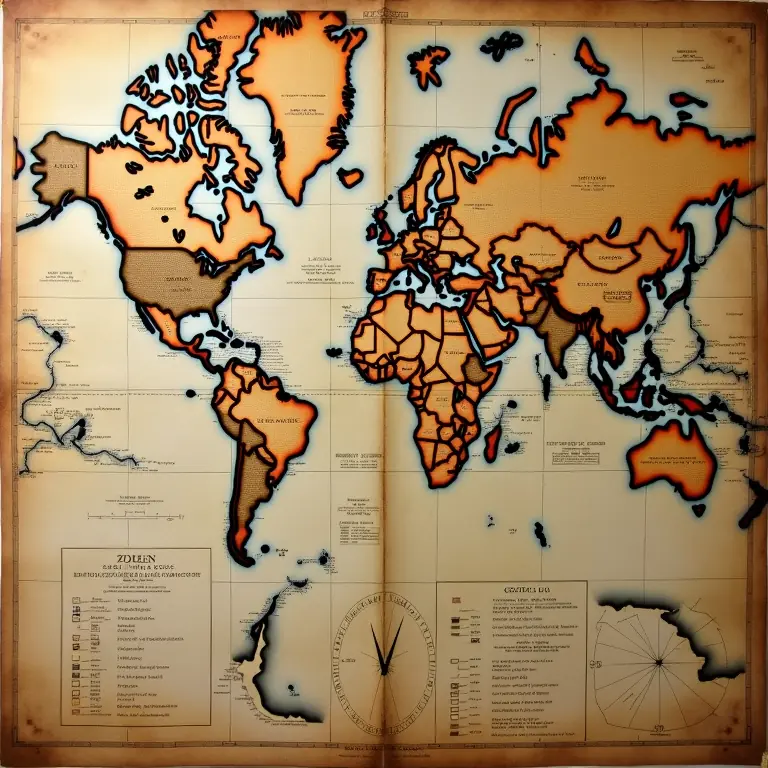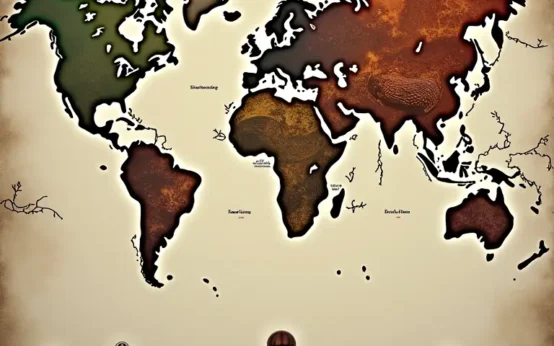For most of human history, telling time wasn’t about knowing what hour it was, but rather understanding where the sun stood in the sky. Life revolved around local solar time – when the sun reached its highest point, it was noon. But as our world became more interconnected, this simple system began to crumble, leading to a surprisingly complex and often contentious journey toward standardized time. It’s a story filled with railway tycoons, astronomical precision, and a global effort to synchronize the planet. Prepare to delve into the unexpectedly precise history of time zones, a story that goes far beyond simply adjusting for sunrise and sunset.
Before Standardization: A World of Local Time
Imagine a world without a shared clock. Before the 19th century, this was reality. Each town kept its own time, based on the apparent motion of the sun. This meant that noon in London wasn’t the same as noon in Bristol, even though they’re only about 120 miles apart. The difference might have been subtle – perhaps a few minutes – but it was enough to cause confusion, particularly with the burgeoning transportation systems. Clocks, of course, existed, but they weren’t set to a universal standard. They were adjusted to local solar noon.
This system worked reasonably well for agrarian societies. Farmers didn’t need to coordinate schedules with distant cities. But the Industrial Revolution changed everything. Factories demanded punctuality, and the advent of railways required precise scheduling to avoid collisions. The growing speed and reach of transportation highlighted the problems inherent in local time. Imagine a railway timetable listing departure times for different towns, each operating on its own slightly different clock – chaos would ensue!
The Railway Problem and the Birth of Standard Time
The railway industry was the primary catalyst for change. In Great Britain, the Great Western Railway (GWR) was an early adopter of a standardized time. In 1840, the GWR decided to adopt ‘Railway Time’, based on Greenwich Mean Time (GMT), throughout its entire network. This wasn’t a nationally mandated change; it was a practical solution to a logistical problem. Other railways followed suit, but inconsistencies remained, as different companies chose different reference points.
The United States faced even greater challenges. With a much larger landmass, the discrepancies in local time were more significant. In 1850, Charles F. Dowd, a Boston publisher, proposed a system of standard time zones based on longitude. He published a table showing the correct time for different zones, but his proposal was largely ignored. The problem wasn’t a lack of a solution, but a lack of widespread acceptance. People were resistant to abandoning local time, which was deeply ingrained in their daily lives. It felt unnatural to operate on a time that didn’t align with the sun’s position.
Greenwich Mean Time: Establishing a Prime Meridian
Central to the development of standardized time was the need for a prime meridian – a line of longitude from which all other longitudes are measured. While several cities vied for the honor, Greenwich, England, ultimately became the accepted standard. This wasn’t a purely scientific decision; it was also influenced by Britain’s dominance in maritime trade and cartography.
The Royal Observatory in Greenwich had been meticulously recording astronomical observations for centuries, and its calculations were highly respected. In 1884, the International Meridian Conference in Washington, D.C., officially adopted Greenwich as the prime meridian. This decision laid the foundation for a truly global system of timekeeping. The conference also agreed upon 24 time zones, each approximately 15 degrees of longitude wide, based on GMT.
The Implementation of Time Zones: Resistance and Compromise
Adopting time zones wasn’t a smooth process. Resistance was particularly strong in rural areas, where people were deeply attached to local time. Farmers, for example, argued that standardized time disrupted their agricultural routines, which were dictated by the sun. Businesses, however, quickly recognized the benefits of standardized time for scheduling and communication.
In the United States, the implementation of time zones was initially left to the railway companies. They adopted the new system in 1883, but it wasn’t until 1918, with the passage of the Standard Time Act, that standardized time became law nationwide. The act also introduced daylight saving time (DST) as a wartime measure to conserve energy.

The Science Behind Time Zones: Longitude and Earth’s Rotation
The underlying principle of time zones is directly related to Earth’s rotation. The Earth takes approximately 24 hours to complete one rotation on its axis, meaning that different longitudes experience sunrise and sunset at different times. Each 15-degree increment of longitude corresponds to a one-hour difference in time.
Longitude itself was a notoriously difficult measurement to make accurately for centuries. Determining longitude requires precise timekeeping – knowing the exact time at a reference point (like Greenwich) and comparing it to the local time. Early methods relied on celestial observations, such as the position of the stars and the moon. However, these methods were often inaccurate, especially at sea.
The development of the marine chronometer in the 18th century, by John Harrison, revolutionized navigation. This remarkably accurate clock allowed sailors to determine longitude with unprecedented precision. Harrison’s chronometer was a crucial step towards the modern system of time zones. You can learn more about the history of navigation and the challenges of determining longitude here.
Time Zone Oddities: Deviations and Political Boundaries
While time zones are generally based on longitude, they often deviate from strict 15-degree increments to accommodate political boundaries, geographical features, or economic considerations. This results in some rather peculiar time zone arrangements. For example, China officially uses a single time zone, Beijing Standard Time, despite spanning five geographical time zones. This decision, made in 1949, was intended to promote national unity.
Other countries, like India, also have time zones that don’t strictly adhere to longitudinal lines. These deviations can lead to some unusual situations. For instance, parts of Russia can experience daylight for nearly 24 hours during the summer months, while other parts experience very short days in the winter.
Coordinated Universal Time (UTC): The Modern Standard
Greenwich Mean Time (GMT) was the standard for many years, but it has been superseded by Coordinated Universal Time (UTC). UTC is based on atomic clocks, which are far more precise than astronomical observations. It’s a highly accurate time standard that is used as the basis for all other time zones around the world.
While UTC is the scientific standard, GMT is still often used colloquially to refer to the time in London. The difference between UTC and GMT is typically small – less than a second – but it’s important to understand that they are not the same thing.
Daylight Saving Time: A Recurring Debate
Daylight Saving Time (DST), the practice of advancing clocks during the summer months to make better use of daylight, remains a controversial topic. Proponents argue that DST saves energy and reduces traffic accidents, while opponents claim that it disrupts sleep patterns and provides little actual benefit. The science behind DST is complex and often debated.

The implementation of DST varies widely around the world. Some countries observe it year-round, while others don’t observe it at all. The debate over DST continues to this day, with ongoing discussions about its potential benefits and drawbacks.
The Future of Time Zones: Adapting to a Changing World
As our world becomes increasingly interconnected, the need for a more rational and efficient system of timekeeping grows. Some have proposed eliminating time zones altogether and adopting a single global time. While this idea has some appeal, it also presents significant challenges.
Another potential solution is to adjust time zone boundaries to better align with political and economic realities. This could involve creating smaller time zones or adopting a system of half-hour offsets. The future of time zones is uncertain, but it’s clear that the current system is not perfect.
The Psychological Impact of Time & Synchronization
Our perception of time is surprisingly malleable and deeply connected to our psychology. The synchronization imposed by time zones, while practical, also influences our biological rhythms and social behavior. Consider the impact of jet lag – a disruption of the body’s natural circadian rhythm caused by crossing multiple time zones.
Interestingly, the power of belief can even influence our experience of time. This is exemplified by the placebo effect, where expectations can alter physiological responses. Similarly, in cases of synesthesia, individuals experience a blending of senses, potentially altering their perception of time’s flow.
Time Zones & Cultural Nuances
Beyond the purely logistical aspects, time zones also play a role in shaping cultural norms and communication patterns. The concept of “prime time” television, for instance, is dictated by time zone differences. Business meetings are scheduled to accommodate participants in different locations. Even social interactions are influenced by the need to coordinate across time zones.
The history of timekeeping is also intertwined with cultural symbolism. Just as flowers carried hidden meanings in Victorian times – explored in the language of flowers – the very act of measuring and organizing time reflects our values and priorities.
The Mathematical Harmony of Time
At its core, the division of a day into 24 hours, and the subsequent creation of time zones, relies on mathematical principles. The consistent division of the circle (representing the Earth) into degrees, and the subsequent calculation of time differences based on longitude, demonstrates a fundamental mathematical harmony. This echoes the underlying mathematical structures found in other areas of science, such as the mathematical principles governing musical harmony.
Ultimately, the story of time zones is a testament to human ingenuity and our ability to overcome logistical challenges. It’s a story that highlights the importance of cooperation, compromise, and a shared understanding of the world around us.


 The Curious Acoustics of Historical Echo Chambers: Resonance, Ritual, and Revelation
The Curious Acoustics of Historical Echo Chambers: Resonance, Ritual, and Revelation  The Curious Cartography of Scent: Mapping Perfume Ingredients Through History
The Curious Cartography of Scent: Mapping Perfume Ingredients Through History  The Curious Lexicon of Lost Trades
The Curious Lexicon of Lost Trades  The Surprisingly Consistent Science of Historical Ice Harvesting – A Frozen History of Commerce & Preservation
The Surprisingly Consistent Science of Historical Ice Harvesting – A Frozen History of Commerce & Preservation  The Unexpectedly Consistent Science of Historical Buttonhooks – Fashion, Function & Forgotten Tools
The Unexpectedly Consistent Science of Historical Buttonhooks – Fashion, Function & Forgotten Tools  The Surprisingly Consistent Science of Historical Toy Soldiers – Miniature Warfare, Materials & Collective Play
The Surprisingly Consistent Science of Historical Toy Soldiers – Miniature Warfare, Materials & Collective Play